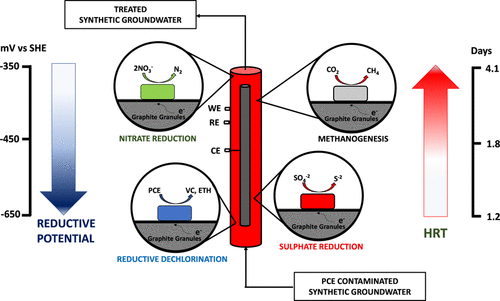Our official English website, www.x-mol.net, welcomes your
feedback! (Note: you will need to create a separate account there.)
Control of Sulfate and Nitrate Reduction by Setting Hydraulic Retention Time and Applied Potential on a Membraneless Microbial Electrolysis Cell for Perchloroethylene Removal
ACS Omega ( IF 3.7 ) Pub Date : 2021-09-22 , DOI: 10.1021/acsomega.1c03001 Edoardo Dell'Armi 1 , Marco Zeppilli 1 , Federica De Santis 1 , Marco Petrangeli Papini 1 , Mauro Majone 1
ACS Omega ( IF 3.7 ) Pub Date : 2021-09-22 , DOI: 10.1021/acsomega.1c03001 Edoardo Dell'Armi 1 , Marco Zeppilli 1 , Federica De Santis 1 , Marco Petrangeli Papini 1 , Mauro Majone 1
Affiliation

|
A membraneless microbial electrolysis cell (MEC) has been developed for perchloroethylene (PCE) removal through the reductive dechlorination reaction. The MEC consists of a tubular reactor of 8.24 L equipped with a graphite-granule working electrode which stimulates dechlorinating microorganisms while a graphite-granule cylindrical envelopment contained in a plastic mesh constituted the counter electrode of the MEC. Synthetic PCE-contaminated groundwater has been used as the feeding solution to test the nitrate and sulfate reduction reactions on the MEC performance at different hydraulic retention times (HRTs) (4.1, 1.8, and 1.2) and different cathodic potentials [−350, −450, and −650 mV vs standard hydrogen electrode (SHE)]. The HRT decrease from 4.1 to 1.8 d promoted a considerable increase in sulfate removal from 38 ± 11 to 113 ± 26 mg/Ld with a consequent current increase, while a shorter HRT of 1.2 d caused a partial inhibition of sulfate reduction with a consequent current decrease from −99 ± 3 to −52 ± 6 mA. Similarly, the cathodic potential investigation showed a direct correlation of current generation and sulfate removal in which the utilization of a cathodic potential of −350 mV versus SHE allowed for an 80% decrease in the sulfate removal rate with a consequent current decrease from −163 ± 7 to 41 ± 5 mA. The study showed the possibility to mitigate the energy consumption of the process by avoiding side reactions and current generation, through the selection of an appropriate HRT and applied cathodic potential.
中文翻译:

通过设置水力停留时间和施加电位来控制无膜微生物电解池去除全氯乙烯的硫酸盐和硝酸盐还原
开发出一种无膜微生物电解池(MEC),用于通过还原脱氯反应去除全氯乙烯(PCE)。 MEC 由一个 8.24 L 的管式反应器组成,配有石墨颗粒工作电极,可刺激脱氯微生物,而塑料网中包含的石墨颗粒圆柱形外壳构成 MEC 的反电极。使用受合成 PCE 污染的地下水作为补料溶液,测试不同水力停留时间 (HRT)(4.1、1.8 和 1.2)和不同阴极电位 [−350、−450] 下硝酸盐和硫酸盐还原反应对 MEC 性能的影响,和-650 mV vs 标准氢电极(SHE)]。 HRT 从 4.1 天减少到 1.8 天,促进硫酸盐去除量显着增加,从 38 ± 11 增加到 113 ± 26 mg/Ld,随后电流增加,而较短的 1.2 天的 HRT 导致硫酸盐还原部分抑制,随后电流增加。从−99±3mA减少到−52±6mA。同样,阴极电位研究显示电流产生和硫酸盐去除存在直接相关性,其中使用 -350 mV 的阴极电位(相对于 SHE)可使硫酸盐去除率降低 80%,随后电流从 -163 ± 7 至 41 ± 5 mA。该研究表明,通过选择适当的水力停留时间和施加的阴极电位,可以通过避免副反应和电流产生来减轻过程的能耗。
更新日期:2021-10-06
中文翻译:

通过设置水力停留时间和施加电位来控制无膜微生物电解池去除全氯乙烯的硫酸盐和硝酸盐还原
开发出一种无膜微生物电解池(MEC),用于通过还原脱氯反应去除全氯乙烯(PCE)。 MEC 由一个 8.24 L 的管式反应器组成,配有石墨颗粒工作电极,可刺激脱氯微生物,而塑料网中包含的石墨颗粒圆柱形外壳构成 MEC 的反电极。使用受合成 PCE 污染的地下水作为补料溶液,测试不同水力停留时间 (HRT)(4.1、1.8 和 1.2)和不同阴极电位 [−350、−450] 下硝酸盐和硫酸盐还原反应对 MEC 性能的影响,和-650 mV vs 标准氢电极(SHE)]。 HRT 从 4.1 天减少到 1.8 天,促进硫酸盐去除量显着增加,从 38 ± 11 增加到 113 ± 26 mg/Ld,随后电流增加,而较短的 1.2 天的 HRT 导致硫酸盐还原部分抑制,随后电流增加。从−99±3mA减少到−52±6mA。同样,阴极电位研究显示电流产生和硫酸盐去除存在直接相关性,其中使用 -350 mV 的阴极电位(相对于 SHE)可使硫酸盐去除率降低 80%,随后电流从 -163 ± 7 至 41 ± 5 mA。该研究表明,通过选择适当的水力停留时间和施加的阴极电位,可以通过避免副反应和电流产生来减轻过程的能耗。











































 京公网安备 11010802027423号
京公网安备 11010802027423号